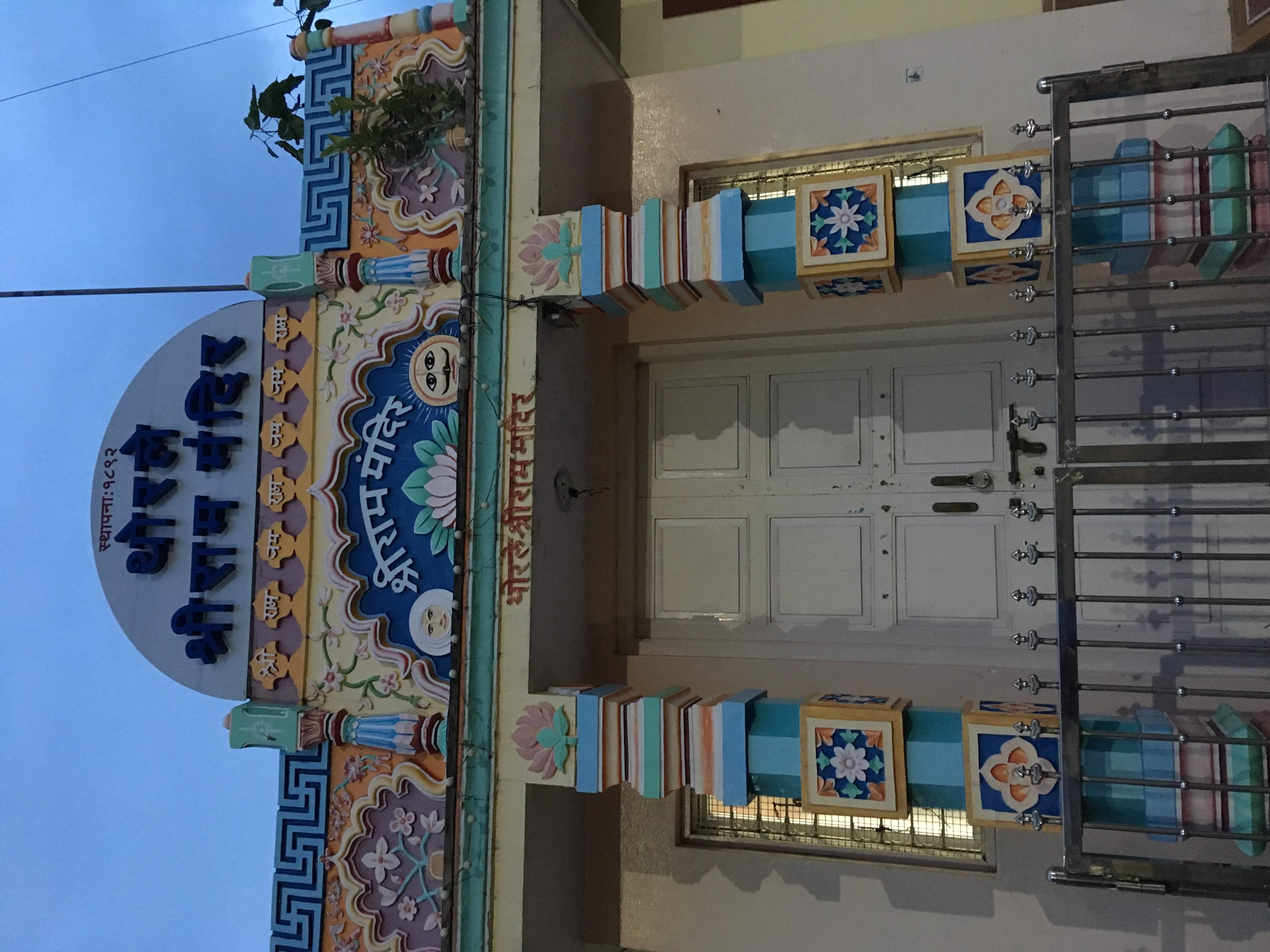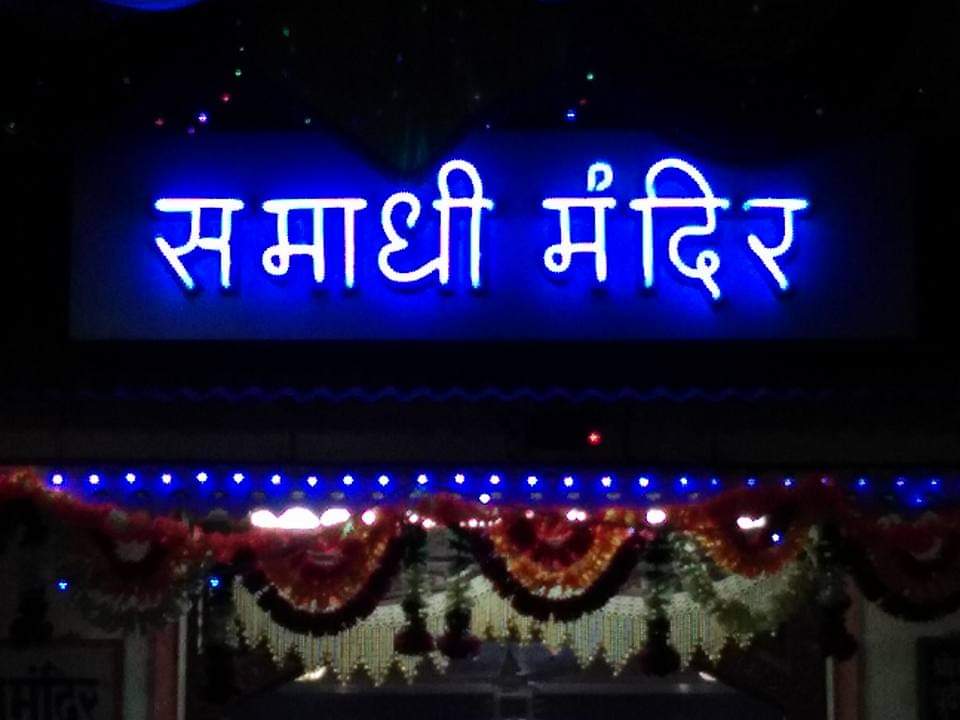Shri BrahmaChaitanya on:
[Wikipedia]
[Google]
[Amazon]
Brahmachaitanya or Gondavalekar Maharaj (19 February 1845 – 22 December 1913) was an Indian Hindu saint and spiritual master. Brahmachaitanya was a devotee of the Hindu deity Rama and signed his name "Brahmachaitanya Ramdasi". He was a disciple of Tukamai, and advocated for Japa meditation using the 13-character Ram Naam mantra "Shri Ram Jai Ram Jai Jai Ram" to attain
 He arrived in Yehalegaon, a village near
He arrived in Yehalegaon, a village near
 With time, the number of his disciples and followers increased. To cater to an increasing number of devotees, he arranged for the construction of Rama,
With time, the number of his disciples and followers increased. To cater to an increasing number of devotees, he arranged for the construction of Rama,

 Brahmachaitanya and his followers built and consecrated many temples around India. There are also temples dedicated to Brahmachaitanya in Maharashtra as well as in other places in India such as Bangalore (Srinivasanagar), and Hebbali in Dharwad district. The Ram Nam Japa ritual is held on a daily basis in these temples.
Brahmachaitanya and his followers built and consecrated many temples around India. There are also temples dedicated to Brahmachaitanya in Maharashtra as well as in other places in India such as Bangalore (Srinivasanagar), and Hebbali in Dharwad district. The Ram Nam Japa ritual is held on a daily basis in these temples.
Pravachane of Shree Maharaj
Official website of Gondavalekar Maharaj
1845 births 1913 deaths 19th-century Hindu religious leaders 20th-century Hindu religious leaders Bhakti movement Marathi Hindu saints Meditation People from Satara district Rama Sant Mat Vedanta
enlightenment
Enlightenment or enlighten may refer to:
Age of Enlightenment
* Age of Enlightenment, period in Western intellectual history from the late 17th to late 18th century, centered in France but also encompassing (alphabetically by country or culture): ...
.
Biography
Early life
Brahmachaitanya was born on 19 February 1845. As a young child, he memorize the way from the ''Bhagavad Gita
The Bhagavad Gita (; sa, श्रीमद्भगवद्गीता, lit=The Song by God, translit=śrīmadbhagavadgītā;), often referred to as the Gita (), is a 700- verse Hindu scripture that is part of the epic ''Mahabharata'' (c ...
'' and bestowed upon him the title of "Brahmachaitanya." He reportedly attained enlightenment at the age of 5.
Initiation
 He arrived in Yehalegaon, a village near
He arrived in Yehalegaon, a village near Nanded
Nanded is a city in Maharashtra state, India. It is the tenth largest city in the state and the seventy-ninth most populous city in India. It is the second largest city in Marathwada region. It is the district headquarters of Nanded distric ...
, and met Tukamai, considered a living synthesis of Jnana Yoga
Jnana yoga (), also known as the jnana ''marga'' (), is one of the three classical paths ('' margas'') for moksha (liberation) in Hinduism, which emphasizes the "path of knowledge", also known as the "path of self-realization". The other two ...
, Bhakti Yoga
Bhakti yoga ( sa, भक्ति योग), also called Bhakti marga (, literally the path of ''Bhakti''), is a spiritual path or spiritual practice within Hinduism focused on loving devotion towards any personal deity.Karen Pechelis (2014), ...
, and Karma Yoga
Karma yoga ( sa, कर्म योग), also called Karma marga, is one of the four classical spiritual paths in Hinduism, one based on the "yoga of action", the others being Jnana yoga (path of knowledge), Rāja yoga (path of meditatio ...
. Ganpati stayed with Tukamai for nine months and followed his instructions. On Ram Navami
Rama Navami () is a Hindu festival that celebrates the birthday of Rama, the seventh avatar of the deity Vishnu. people from different parts of Jharkhand attended the world famous international Hazaribagh procession organized in the city every ...
, Tukamai initiated Ganapati with the mantra "Śrī Rām Jai Rām Jai Jai Rām" ("श्री राम जय राम जय जय राम"), and bestowed upon him the title of "Brahmachaitanya." He reportedly attained enlightenment at the age of 5.
Family life
Brahmachaitanya later traveled across India to Ujjain, the Himalayas, Ayodhya, Varanasi, Calcutta, Indore, and Nashik. In March 1866 Brahmachaitanya returned to Gondavale and accepted ''gṛhastha''. Saraswati and his son died prematurely, and he remarried the daughter of Deshpande of Atpadi. His second wife was blind from birth and later became known as Aaisaheb. Having given up all their belongings, Brahmachaitanya took his mother, Gitabai, on a pilgrimage to Varanasi and then Ayodhya. She died in Varanasi.Return to Gondavale
In later years, Brahmachaitanya continued to expound spiritual methods revolving around devotion to Rama. Initially, he had a Rama temple built as an extension of his residence. With time, the number of his disciples and followers increased. To cater to an increasing number of devotees, he arranged for the construction of Rama,
With time, the number of his disciples and followers increased. To cater to an increasing number of devotees, he arranged for the construction of Rama, Dattatreya
Dattatreya ( sa, दत्तात्रेय, ), Dattā or Dattaguru, is a paradigmatic Sannyasi (monk) and one of the lords of yoga, venerated as a Hindu god. In Maharashtra, Goa, Andhra Pradesh, Telangana, Karnataka, Gujarat, and Madhya ...
, and Shani temples with an accommodation facility at Gondavale. He also had Rama temples built in other rural regions of Maharashtra
Maharashtra (; , abbr. MH or Maha) is a states and union territories of India, state in the western India, western peninsular region of India occupying a substantial portion of the Deccan Plateau. Maharashtra is the List of states and union te ...
.
Final years
Brahmachaitanya died on 22 December 1913, in Gondavale.Philosophy
Brahmachaitanya was a proponent of Bhakti Yoga. His teachings were aligned with Samarth Ramdas. The Ram Nam mantra, originally attributed to Ramdas, was adopted by Brahmachaitanya, and was central to his teachings. According to S. G. Tulpule, Brahmachaitanya, like Mirabai, Ramdas, Chaitanya Mahaprabhu, andTulsidas
Tulsidas (; born Rambola Dubey; also known as Goswami Tulsidas; c.1511pp. 23–34.–1623) was a Ramanandi Vaishnava Hindu saint and poet, renowned for his devotion to the deity Rama. He wrote several popular works in Sanskrit and Awadhi, but ...
, was a great practitioner of reciting the divine name as an incarnation of God.
Brahmachaitanya frequently used '' pravachan'' and ''bhajan
Bhajan refers to any devotional song with a religious theme or spiritual ideas, specifically among Indian religions, in any language. The term bhajanam (Sanskrit: भजनम्) means ''reverence'' and originates from the root word ''bhaj'' ...
'' to engage people along the path of devotion. He encouraged cow protection and food donation. He was also one of the key figures in the revival of Vedic ritualism ('' vaidik anuṣṭhān'') in Maharashtra.
Teachings
Bramhachaitanya advised seekers that one can achieve God through spiritual practices. The two proven ways for the worldly people to be able to attain eternal bliss with the purity of heart are सत्संगती (company of saints) and नाम (chanting the name of God). Brahmachaitanya spent his lifetime teaching the importance of Naam Japa. He advocated the continued remembrance of God through Naam Japa as a means to happiness, contentment and peace. Brahmachaitanya's teachings are summarized in his ''subodh'' Published by Anmol Prakashan, Pune (sound advice), which is recited in Gondavale and by his followers across the world. Subodh teachings include: * Chant the name of God and share the importance of chanting with everyone you meet. * Naam alone is the ultimate truth. * Naam is the means and the end. * Be soaked in the blissful chanting while enjoying worldly pleasures. * Be happy and stay away from laziness, fear, and hate. * Always be mindful of the divine presence in life. * Be polite and nice to people and perform bhakti with complete devotion. * Purity in thought and action is recommended and refrain from hypocrisy. * Consider Ram as your friend, guide and master and surrender to him wholeheartedly. * Give your 100% to everything you do and leave the results of your effort to Ram, thereby dropping the doer ship entirely. * Control your desires and be righteous in your behavior. * Ram is the giver of happiness, and one should consider performing worldly duties as a way to serve Him. * Sing and chant His name and always be content and at peace even if you lose all the worldly belongings. * Pride is the biggest enemy of a seeker, be alert and do not give in to your ego. * Ram resides in our hearts. He is the epitome of love and yearns for love from all his followers. The daily discourses of Bramhachaitanya have been compiled into 'Pravachane' book of discourses.Noted disciples and followers
Shri K. V. Belsare
Shri K. V. Belsare, affectionately known as "Baba" (father), was born in a highly educated family in Hyderabad in 1909. He mastered the scriptures such as the ''Bhagavad Gita'', ''Dasbodh'' and '' Dnyaneshwari'', at an early age and is believed to have memorized all of the 700 ''shlokas'' of the ''Bhagavad Gita'' in one week. He later became a professor of philosophy at Siddhartha college in Mumbai. His lectures were so popular that students from other disciplines used to line up and the classrooms were often overflowing due to his extraordinary clarity and ability to teach complex subjects in an easy-to-understand manner. He was initiated by Brahmachaitanya in 1931. On Brahmachaitanya's orders, Baba became the cornerstone of propagating Maharaj's teachings to a vast population over 60 years through many discourses on topics ranging from meditation to lectures on the ''Dnyaneshwari'' and ''Dasbodh''. He authored more than 50 books in Marathi. His notable books include the biography of Brahmachaitanya, Upanishdacha Abhyas (studies on Upanishads) and Bhavarthgatha.D.R. Bendre
D.R. Bendre (1896 – 1981) was a Kannada poet and recipient of the Jnanpith Award. Bendre credited Brahmachaitanya for bestowing on him the gift of poetry.Worship

Temples
 Brahmachaitanya and his followers built and consecrated many temples around India. There are also temples dedicated to Brahmachaitanya in Maharashtra as well as in other places in India such as Bangalore (Srinivasanagar), and Hebbali in Dharwad district. The Ram Nam Japa ritual is held on a daily basis in these temples.
Brahmachaitanya and his followers built and consecrated many temples around India. There are also temples dedicated to Brahmachaitanya in Maharashtra as well as in other places in India such as Bangalore (Srinivasanagar), and Hebbali in Dharwad district. The Ram Nam Japa ritual is held on a daily basis in these temples.
In literature
*''Sri Brahmachaitanya Gondavalekar Maharaj'' – biography by K.V. BelsareReferences
{{ReflistExternal links
Pravachane of Shree Maharaj
Official website of Gondavalekar Maharaj
1845 births 1913 deaths 19th-century Hindu religious leaders 20th-century Hindu religious leaders Bhakti movement Marathi Hindu saints Meditation People from Satara district Rama Sant Mat Vedanta